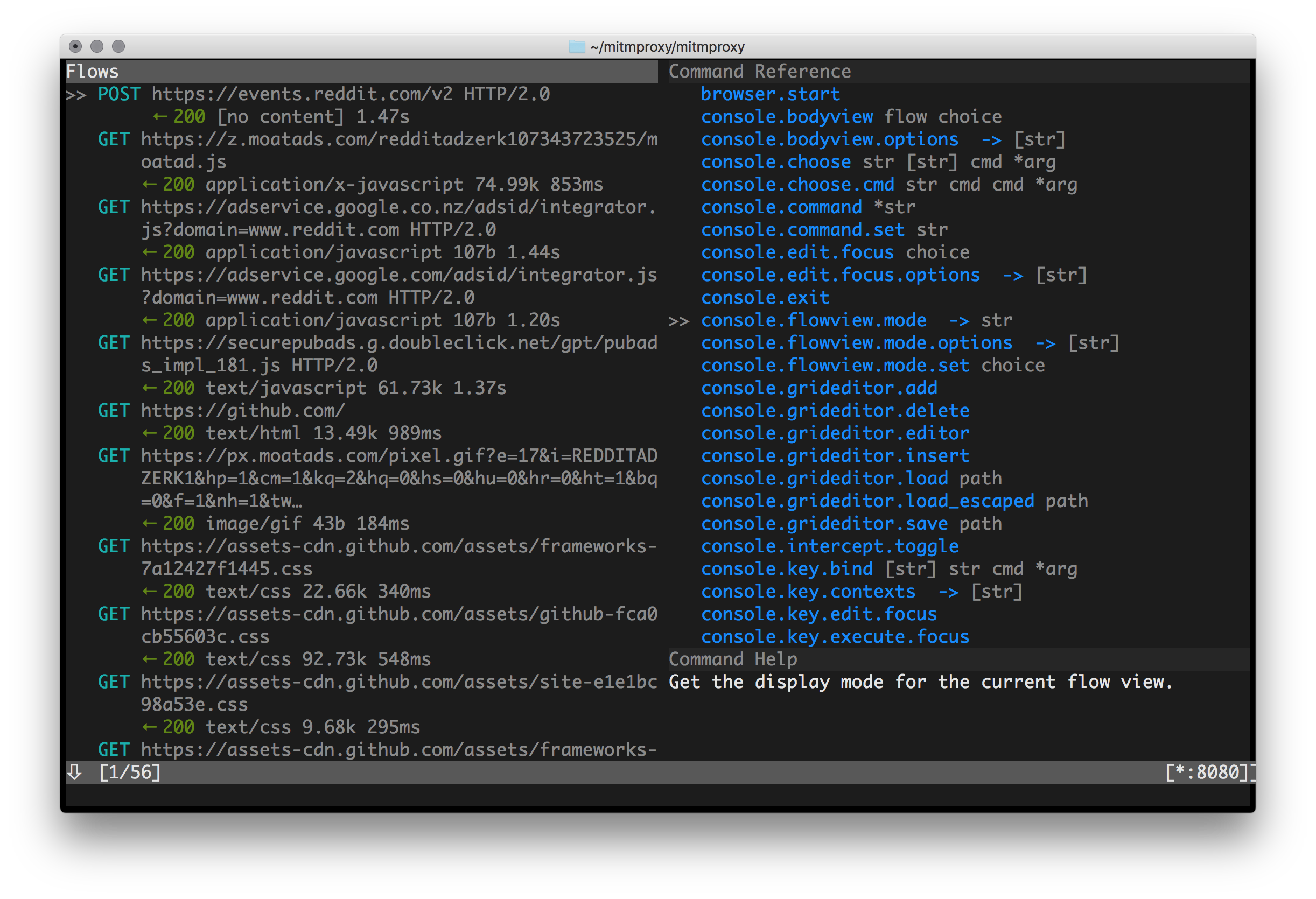Mitmproxy 3
23 Feb 2018, Aldo Cortesi @cortesi
We’re delighted to announce the release of mitmproxy v3.0. This is a massive milestone release, featuring a substantial revamp of mitmproxy’s internal structure and serious improvements in all tools across the board. Everyone should update!
The project’s momentum remains fearsome: this release features 1235 commits by 56 contributors, resulting in 287 closed issues and 308 merged PRs. With this release, we’re also launching a new website (you’re looking at it), a new project blog (you’re reading this release notice on it), and cleaner docs.
Let’s dig into the details.
Internals
Mitmproxy now has a powerful new addon infrastructure. Addons can hook into mitmproxy’s internal events, can expose typed options for configuration, and can create typed commands for user interaction. We’ve migrated much of mitmproxy’s own functionality into a set of internal addons, resulting in a much cleaner and more maintainable code structure.
Perhaps the most exciting aspect of this change is the power it gives third-party addons and user scripts. We expose precisely the same functionality mitmproxy uses for itself to users. Typed options declared by addons automatically appear in type-aware options editors in the official tools, are automatically included in configuration files, and can automatically be controlled from the command line. Typed commands exposed by addons get tab completion in mitmproxy console for free, and can be bound to keys. If you’re working on an extension of mitmproxy, please let us know - mitmproxy addons are now more powerful and easier to write than ever, and we’d like your feedback to help us make them better still.
Mitmproxy console

The mitmproxy console app has been rebuilt around the new addon mechanism. Every user interaction and key binding simply invokes an addon command. Keystrokes can be bound directly to commands, and the command language can be invoked from an interactive, smart, syntax-aware prompt. User addons and scripts are first-class citizens, and get the same tab completion, type-aware options editor and key binding support as builtins.
The introduction of commands makes mitmproxy a massively more flexible and powerful tool. Any operation on flows can be invoked from the command prompt and combined with flow selectors. So, for instance, we can replay all flows with the domain “google.com” like so:

Along with this comes many, many user interface improvements. Major changes
include horizontal and vertical multi-pane layouts, customizable keybindings, an
options editor, and a command palette. There are too many minor improvements to
list, but my personal favourite is the new “B” keybinding (the browser.start
command), which opens an isolated instance of Chrome automatically set up to go
through the running proxy. Very handy.
Mitmweb, protocol support and others
As usual, there are many other improvements in this release. Mitmweb, the mitmproxy web interface, has continued to mature with a new options editor, and many other improvements. This will open a slew of new use cases for our toolset down the track. Mitmproxy’s content views - including the beautifiers for JavaScript and CSS and image summary viewers - are now faster and better. Our underlying protocol support has improved, with a better websockets stack and the introduction of request streaming for HTTP1 and HTTP2.
For a complete list of changes, see the CHANGELOG.
GSoC
Of special note during this release cycle is the work of our two brilliant Google Summer of Code 2017 students, who participated in mitmproxy’s development under the umbrella of the Honeynet Project. Matthew Shao made major improvements to the mitmproxy web interface, including adding a new options editor, vastly improving our testing, and working on a static web viewer for mitmproxy dumps. Matthew wrote a detailed blog about his work on the HoneyNet blog. Ujjwal Verma pushed our content views and protocol layers ahead very significantly. You can thank him for faster, more stable decoding of images, protobufs, and better prettifying of JavaScript and CSS. He also migrated our websockets implementation to wsproto, and added request streaming to HTTP1 and HTTP2. We look forward to working with both Matthew and Ujjwal in the years to come.
Are you a student and interested in working on mitmproxy? Take a look at our GSoC 2018 page!
Survey
Mitmproxy doesn’t have telemetry and collects as little data as possible on its users. We rely on your manual feedback to let us know what to build. Please take a moment to fill in the 2018 mitmproxy user survey - this feeds directly into our dev priorities for the next year.